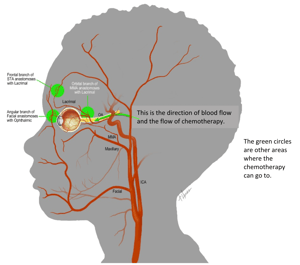What is Intra-arterial chemotherapy?
It is a way to give medicine (chemotherapy) to treat fast growing cells. The medicine is put into the artery of the eye (ophthalmic artery).

Who can get this kind of treatment?
It is used for tumors that affect one eye or for eye tumors that come back. Your provider will talk with you if your child will get this treatment.
What is the benefit of this treatment?
Giving chemotherapy into to the eye helps protect other body cells from chemotherapy damage. This is the best way to get the medicine to the tumor.
How is the procedure done?
It is done under general anesthesia by a neurosurgeon.
- A needle stick is made in the artery around the groin.
- A small tube called a catheter is then put into the artery and threaded up to the eye artery.
- The chemotherapy is then given slowly through the catheter.
- After, the catheter is removed and a dressing is put on the area.
The procedure is done again every 4 weeks, for 3 cycles or times. Some may need up to 6 cycles.
What chemotherapy is used?
The chemotherapy may be a single medicine or more than one medicine. Melphalan is used most often. Your provider will decide what chemotherapy is needed based on the type of tumor.What is the success of shrinking the tumor?
This is based on the type and size of your child’s tumor. Your provider will discuss this with you.What are the risks of having this procedure done?
These things could happen from this procedure:
- Eye redness
- Eyelid swelling
- Eye pain
- Hard to move the eye around
- Vision loss or blindness
- Bleeding from the groin where the catheter was put into the skin
- Side effects from the chemotherapy (this includes upset stomach, throwing up, and low blood counts)
- Your provider will order blood counts to be monitored every week



